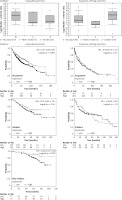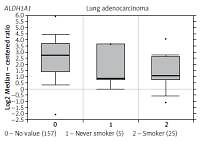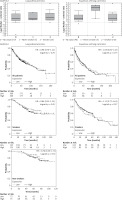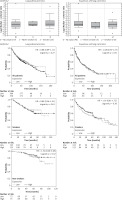Introduction
Lung cancer is the leading cause of cancer-related death worldwide [1]. Non-small cell lung carcinoma (NSCLC) includes two main types: lung squamous cell carcinoma (LUSC) and lung adenocarcinoma (LUAD) [2]. Although many factors can affect the occurrence and development of lung cancer [3, 4], we all know the basic fact that smoking causes lung cancer. A comprehensive molecular profile is needed to elucidate tumorigenesis of smokers and non-smokers with lung cancer.
The ALDH1 family of enzymes (namely ALDH1A1, ALDH1A2 and ALDH1A3) is a cytosolic detoxifying enzyme responsible for the oxidation of (retin)aldehydes into retinoids [5]. It has been widely used to isolate cancer stem cells [6]. ALDH1 is involved in cell proliferation, differentiation, and drug resistance [7]. Ginestier et al. [8] found that ALDH1A1 expression detected by immunostaining correlated with poorer breast cancer patient prognosis. However, Neumeister et al. [9] found that ALDH1A1 expression alone does not significantly predict the therapeutic outcome of breast cancer patients. So, it is hard for a single study to assess the robustness of the relationship between ALDH1A1 expression and the clinicopathologic parameters of cancer patients. The objective of this project is to explore the impact of tobacco consumption and histology type on ALDH1 expression.
Material and methods
Oncomine database analysis
The mRNA levels of ALDH1A1, ALDH1A2 and ALDH1A3 in lung cancer tissues were compared with their matched normal tissues by using TCGA datasets in the Oncomine database (http://www.oncomine.org). The threshold used to obtain the most significant probes of the queried gene for each microarray data included a two-fold difference in expression between cancers and normal tissues with a p-value < 1 × 10–4.
Kaplan-Meier plotter analysis
The prognostic value of ALDH1A1, ALDH1A2 and ALDH1A3 in lung cancer was analyzed using the Kaplan-Meier (KM) plotter (http://kmplot.com/analysis/). Overall survival of patients with high and low levels of ALDH1A1, ALDH1A2 and ALDH1A3 was shown using a Kaplan-Meier survival plot.
Results
ALDH1A1, ALDH1A2 and ALDH1A3 in LUSC and LUAD tissues
Based on the Oncomine analysis of cancer vs. normal tissue, we found that ALDH1A1 mRNA was significantly higher in the LUSC tissues of smokers than that in non-smokers (Figure 1). ALDH1A3 mRNA was significantly lower in the LUSC tissues of smokers than that in non-smokers (Figure 2). No significant difference of ALDH1A2 mRNA was found in LUSC tissues of smokers and non-smokers (Figure 3). ALDH1A1, ALDH1A2 and ALDH1A3 showed no significant difference in LUAD tissues of smokers and non-smokers (Figures 1–3). Kaplan-Meier analysis revealed that high ALDH1A1 mRNA was correlated with a benign survival rate of non-smokers with LUAD (p = 0.047, Figure 1). No influence of ALDH1A2 and ALDH1A3 mRNA was found in either smokers or non-smokers with LUSC or LUAD (p > 0.05, Figures 1–3).
Figure 1
ALDH1A1 mRNA was evaluated in both smokers and non-smokers with LUSC or LUAD using Oncomine analysis. Univariate Kaplan-Meier survival analysis of ALDH1A1 in both smokers and non-smokers with LUSC or LUAD was performed using datasets compiled with KM plotter

Discussion
In this brief report, we used bioinformatics analysis to describe the mRNA levels of ALDH1 family members (ALDH1A-3) in LUSC and LUAD tissues. In the study of Patel et al., they found higher expression of ALDH1A1 in lung specimens from smokers when compared to non-smokers [10]. Consistent with their study, a higher ALDH1A1 mRNA level was found in the LUSC tissues of smoker in this study. Cigarette smoking seems to be an inducer of ALDH1A1. You et al. [11] found that ALDH1A1 mRNA in NSCLC is associated with better prognosis. In this study, we found that high ALDH1A1 mRNA was correlated with a benign survival rate of non-smokers with LUAD using the KM plotter. In most cancers, high expression of the ALDH1A1 protein was associated with a poor prognosis, such as breast cancer [12], colorectal carcinoma [13], and gastric cancer [14]. In a meta-analysis, ALDH1 was an independent factor associated with reduced survival of lung cancer patients [13]. Based on the present data, we cannot conclude the reason for the discordance between ALDH1A1 protein and mRNA [15].
In conclusion, our results showed that ALDH1A1 mRNA could be used as a favorable marker of non-smokers with LUAD. This marker should be further evaluated for its potential use in tracking lung cancer stem cells in vivo and in vitro.





